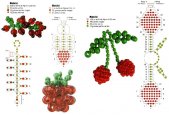Biser is small glass booths or other materials that have been drilled, of which the necklace, bracelets and other jewels are floated.
Biser's story takes root in a long past. The great decorational material attracted the attention of the masters from time immemorial.
The art of building jewelry was practically the same time people showed up. Even when there was no beaver as such, a man was wearing a thread of a thread of beautiful stones or fangs of dead animals. Busins were still relevant at the time of the first civilizations and were used by our ancestors as decorations and to protect themselves from evil spirits. In the ancient excavations of many of our planets, cultivated stones with drilled holes were found.
Natural materials such as seeds, brushes, nuts, shells, claws and bones of various animals were used as jewellery. It was considered that the wearing of animal bones either protected the attacking animal or gave the man the spirit of the animal, making him courageous and powerful. Some of our ancestors were making bushes out of the clay, painting them and burning them. Steel belts are starting to develop. Biser was used in the creation of decorations, talismans, served as a dense coin and was a symbol of wealth and power.
Through the jewelry, man expressed his understanding of peace. This has been particularly prevalent among indigenous Americans. Indians stole home Bus, brassed ribbons in the hair, sewed their suits. The booths stole everything: tax bandages, ritual belts, baby bulbs, tobacco. In North America, there are beads made from feathers and sinks. The beads for their decorations were made by Indians from various materials, by coral, silver, bilge, etc. Maya and olemeki used nephrit. Also, the researchers found buffins from the mountain crystal and gold. In ancient Egypt, crystals were used as material.










